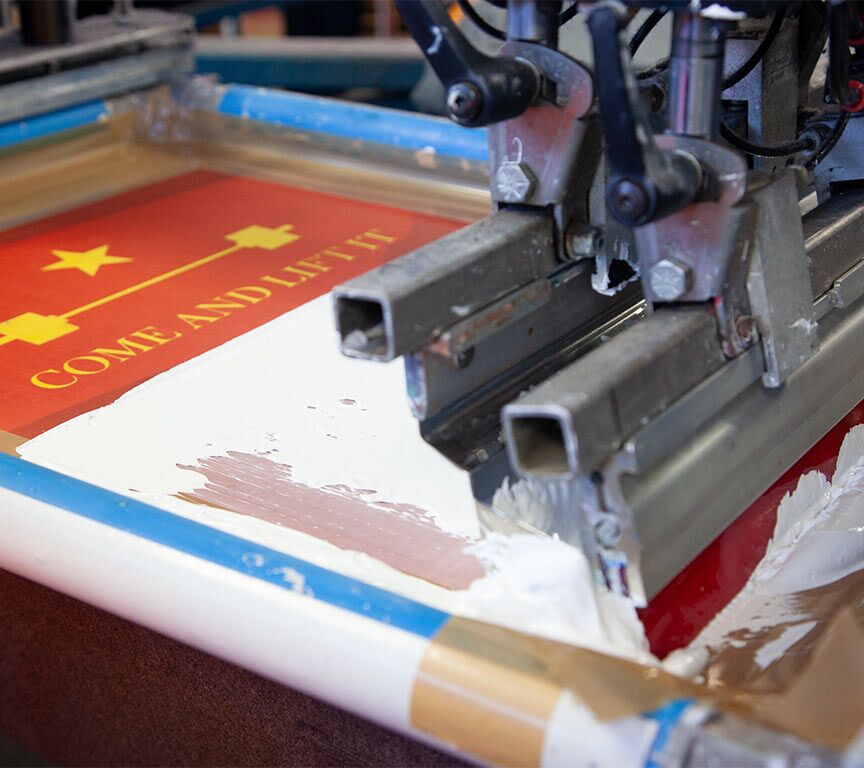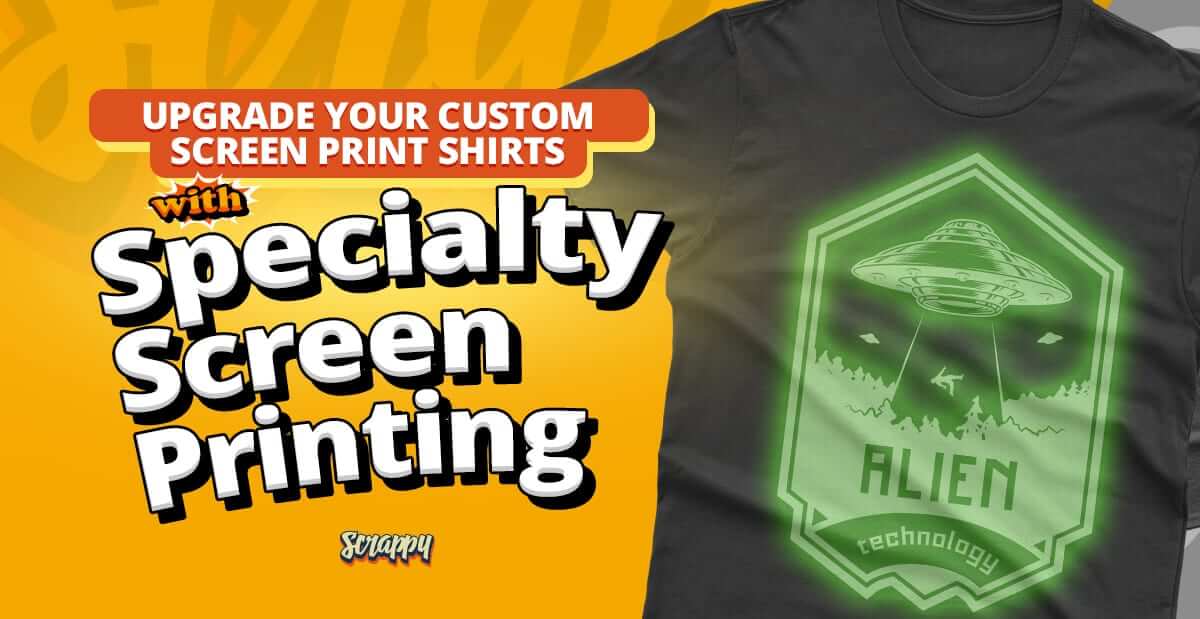Affordable Custom Screen Printing Services for Small Businesses
Affordable Custom Screen Printing Services for Small Businesses
Blog Article
Display Printing Uncovered: Every Little Thing You Need to Find Out About Tee Shirt and Garment Printing Methods
Display printing is a fascinating technique that integrates art with technique, offering limitless possibilities for creative thinking. Ready to check out the necessary components that make screen publishing an art type?
The Fundamentals of Display Printing: Exactly How It Functions
When you plunge into screen printing, you'll discover it's both an art and a scientific research. At its core, screen printing involves developing a stencil, or display, that permits ink to pass via just in particular locations.
Setting the display over the material, then make use of a squeegee to press ink via the display onto the garment. Each action is necessary, and mastering them will boost your display printing skills, changing basic garments right into special, expressive pieces.
Sorts Of Screen Printing Techniques
As soon as you realize the fundamentals of screen printing, it's time to explore the different techniques that can elevate your designs. One popular approach is traditional screen printing, where ink is pushed with a stenciled display. This technique is terrific for bold, dynamic colors. There's water-based ink printing, which provides a softer feel and is environment-friendly, yet it needs a different method to treating.
If you're intending for fine information, consider discharge printing. This technique removes dye from the fabric, leaving a soft, vintage look. An additional option is plastisol printing, understood for its toughness and vibrant colors, making it a preferred for several brands. Experiment with halftone printing to create slope results and elaborate styles. Each strategy has its unique charm, so do not hesitate to try them bent on locate what matches your design best!
Necessary Tools for Display Printing
To accomplish stunning results in screen printing, having the appropriate devices is basic. You'll need a sturdy screen printing structure, which holds the mesh that transfers your layout onto the garment. Next off, spend in top quality squeegees; these are necessary for using ink uniformly across the display.
Picking the Right Inks and Materials
When picking inks and products for screen printing, you require to take right into account the kind of ink that works best for your task. Consider textile compatibility to assure your designs look last and fantastic lengthy. Discover eco-friendly ink choices to make your printing process a lot more lasting.
Sorts Of Screen Inks
Choosing the best screen ink is necessary for achieving vibrant, sturdy prints that fulfill your project's demands. There are numerous sorts of display inks to examine. Plastisol ink is popular for its flexibility and ease of usage, supplying excellent shade opacity on dark fabrics. Water-based ink, on the various other hand, offers a softer feeling and is environment-friendly, making it perfect for those aiming to reduce their environmental impact. Release inks eliminate dye from the material, causing a soft, vintage appearance however require particular handling. Ultimately, specialized inks, such as metal or glow-in-the-dark, can include special effects to your designs. Review your task requirements and pick the ink that straightens best with your preferred result.

Material Compatibility Factors To Consider
Understanding fabric compatibility is important for accomplishing high-quality screen prints, specifically because various products react distinctly to different inks. When picking inks, think about the material type-- cotton, polyester, or blends. For cotton, water-based inks function well, offering softness and breathability. Polyester, on the various other hand, usually calls for plastisol inks for better adhesion and vibrant shades. If you're publishing on blends, you may need to use a combination of both kinds. Always evaluate your inks on sample fabric to assure they stick effectively and maintain color stability. In addition, bear in mind that textile weight and structure can impact the last end result, so choosing the ideal ink and product combination is important for your project's success.
Eco-Friendly Ink Options
Eco-friendly inks are becoming a popular selection for screen printers that desire to decrease their environmental impact while maintaining high quality. When choosing inks, take into consideration water-based inks, which are less hazardous and simpler to cleanse up contrasted to traditional solvents.
Additionally, seek inks made from renewable resources, such as soy or vegetable-based options. By selecting the ideal inks and materials, you'll not only create sensational layouts however also contribute to a much more lasting printing procedure. Make the switch, and your prints will reflect your dedication to the atmosphere!
Preparing Your Style for Screen Printing

Submit Format Demands
To guarantee your layout looks sharp and dynamic on textile, you'll need additional hints to pay close attention to file format demands for screen printing. Make certain your style has a transparent history to prevent undesirable white sides on your prints. Maintain color settings in mind; CMYK is common for display printing, so transform your RGB makes as necessary.
Shade Splitting Up Strategies
Shade separation is a necessary action in preparing your layout for screen printing, and mastering it can substantially improve your print high quality. You'll need to break your layout into specific shades, as each color calls for a different screen throughout printing. Start by determining all the shades in your design and develop layers each. You can utilize software program like Adobe Photoshop or Illustrator to isolate and separate shades effectively. Be particular to save each layer as a different data, generally in a layout like TIFF or PSD. This accuracy not only ensures precise color depiction but also enhances the printing process. By paying focus to color splitting up, you'll accomplish specialist and lively cause your screen-printed garments.
Resolution and Dimension
Achieving the most effective cause screen printing starts with assuring your design has the right resolution and dimension. Preferably, your art work ought to go to the very least 300 DPI (dots per inch) for sharp, clear prints. If you use reduced resolution, your last item might look pixelated and amateur.
When it comes to dimension, take into consideration the dimensions of your print location. Design your go right here art work to match the last print size, preferably creating it in the actual measurements you'll be printing. By doing this, you'll prevent any type of unanticipated scaling issues.
Constantly check your layout in both vector and raster layouts. Vector graphics can be scaled without losing quality, making them suitable for display printing. Preparing properly will assure your style looks remarkable on every garment!
Step-by-Step Display Printing Refine
Screen printing is a vibrant process that permits you to create lively layouts on different surface areas. To get going, you'll need a screen, solution, and your chosen ink. Prepare your display by cleansing it extensively. Next off, apply the solution uniformly and let it completely dry in a dark location. Once completely dry, expose your screen to light with your layout positioned on it, click site which will solidify the solution where the light hits, creating a stencil - screen printing kit.
After cleaning out the unexposed emulsion, your display is all set. Set it up on your printing surface area and straighten your garment underneath it. Put ink onto the display and use a squeegee to press the ink through the stencil onto the textile. Lift the screen carefully and allow the print completely dry. Lastly, treat the ink making use of heat to ensure durability. That's it! You have actually effectively display published your layout.
Tips for Successful Display Printing Projects
While you're diving right into your display printing tasks, bear in mind that prep work is essential to success. Begin by collecting all your products-- inks, garments, squeegees, and displays. A tidy office helps avoid unwanted mistakes, so clean before you begin.
Following, validate your art work is high-resolution and effectively sized for your garment. Evaluate your screen for appropriate direct exposure and clean it completely to prevent smudges. When mixing your inks, adhere to the supplier's guidelines to achieve the ideal uniformity.
During printing, use even stress with your squeegee for consistent results. Do not rush; take your time to confirm each print fulfills your requirements. After printing, let your garments completely dry completely before dealing with or packaging them.
Finally, always keep a sample of your help future reference. This means, you can evaluate your progression and improve your strategies with time. Pleased printing!

Regularly Asked Questions
How much time Does It Take to Establish a Screen Printing Job?
Establishing a screen printing task usually takes around 30 minutes to an hour. You'll prepare the screens, mix inks, and readjust journalism. The time varies based on intricacy and experience, so remain organized!
Can I Print on Various Material Enters Making Use Of the Same Strategy?
Yes, you can print on various fabric kinds making use of the exact same technique, however you'll need to adjust your setups and inks. Some fabrics take in ink differently, so trying out warranties the very best results for each and every material.
What Prevail Errors to Prevent in Display Printing?
When screen printing, avoid common mistakes like utilizing the incorrect ink, neglecting correct exposure times, or avoiding pre-press checks. Always evaluate your arrangement and preserve tidy screens to guarantee high quality results each time.
Exactly How Can I Effectively Tidy and Maintain My Display Printing Tools?
To correctly clean and preserve your display printing tools, you need to consistently clean displays with appropriate solvents, examine squeegees for wear, and ensure all tools are stored dry and dust-free. Consistency boosts and stops costly fixings performance.
Is Screen Printing Environmentally Pleasant Contrasted to Various Other Techniques?
Screen printing can be more eco-friendly than various other methods, particularly if you utilize eco-conscious materials and water-based inks. By picking sustainable materials and methods, you minimize waste and reduce your effect on the planet.
Screen Printing Uncovered: Everything You Need to Know Regarding T-Shirt and Garment Printing Strategies
At its core, display printing involves developing a stencil, or screen, that enables ink to pass via just in certain areas. Position the display over the textile, after that make use of a squeegee to press ink through the screen onto the garment. One preferred technique is typical display printing, where ink is pressed via a stenciled display.When selecting inks and products for screen printing, you need to take right into account the type of ink that works finest for your task.
Report this page